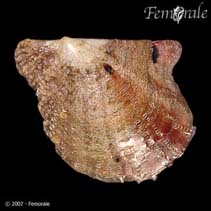Pinctada radiata (Leach, 1814)
Rayed pearl oyster| Native range | All suitable habitat | Point map | Year 2050 |

|
| This map was computer-generated and has not yet been reviewed. |
| Pinctada radiata AquaMaps Data sources: GBIF OBIS |
Classification / Names Common names | Synonyms | CoL | ITIS | WoRMS
Gastropoda | Ostreida | Margaritidae
Environment: milieu / climate zone / depth range / distribution range Ecology
Benthic; depth range 0 - 150 m (Ref. 348), usually 5 - 25 m (Ref. 348). Tropical
Distribution Countries | FAO areas | Ecosystems | Occurrences | Introductions
Indo-Pacific and the Mediterranean Sea: from East Africa, to Melanesia and Hawaii; north to Japan and south to northern Victoria. Mediterranean Sea: Greece. Subtropical.
Length at first maturity / Size / Weight / Age
Maturity: Lm 3.8 range ? - ? cm Max length : 10.1 cm SHH male/unsexed; (Ref. 127024); common length : 6.0 cm SHH male/unsexed; (Ref. 348)
Short description Morphology
Shell rather thin and small to medium sized, relatively inflated, subquadrate in outline, with a short and ill defined posterior ear which is not drawn out into a wing-like process. Dorsal margin relatively long, anterior margin protruding only slightly or not at all beyond the tip of anterior ear. Outer surface of shell, when not worn, with densely set, appressed and flattened, imbricating concentric scales and moderately small, radially projecting spines mostly preserved towards the margins. Hinge line with 2 small teeth in each valve: 1 rounded anterior tubercle just in front of the umbo, and 1 posterior ridge, situated behind the ligamental area and almost parallel to dorsal margin. A small accessory ridge sometimes present above the posterior tooth of right valve. Colour: outside of shell variable, uniform or with darker markings or radial rays, mostly of reds and browns, but sometimes of green and bronze coloration. internal nacreous area highly iridescent. Non-nacreous margin glossy, light brown with dark brown or reddish blotches corresponding to the main external rays.
Collected in many areas of the Indo-West Pacific for its edible muscle, nacreous shell and ability to develop pearls (348). Byssally attached to rocks, dead corals and various submerged objects, often forming large natural banks. On soft bottoms, they aggregate to one another. Littoral, sublittoral and shelf zone, from low tide levels to a depth of about 150 m. Most common on sublittoral bottoms, from depths of 5 to 25 m (Ref. 348).
Life cycle and mating behavior Maturity | Reproduction | Spawning | Eggs | Fecundity | Larvae
Life cycle: Embryos develop into free-swimming trocophore larvae, succeeded by the bivalve veliger, resembling a miniature clam (Ref. 833).
Main reference
References | Coordinator | Collaborators
Poutiers, J.M. 1998. (Ref. 348)
IUCN Red List Status (Ref. 130435)
CITES status (Ref. 108899)
Not Evaluated
CMS (Ref. 116361)
Not Evaluated
Threat to humans
Human uses
Fisheries: commercial
| FishSource |
Tools
More information
Internet sources
BHL | BOLD Systems | CISTI | DiscoverLife | FAO(Publication : search) | Fishipedia | GenBank (genome, nucleotide) | GloBI | Gomexsi | Google Books | Google Scholar | Google | PubMed | Tree of Life | Wikipedia (Go, Search) | Zoological Record
Estimates based on models
Preferred temperature
(Ref. 115969): 20.5 - 29.1, mean 27.9 (based on 1624 cells).
Resilience
(Ref. 69278):
High, minimum population doubling time less than 15 months (K=0.25-1.7).
Price category
(Ref. 80766):
Unknown.



